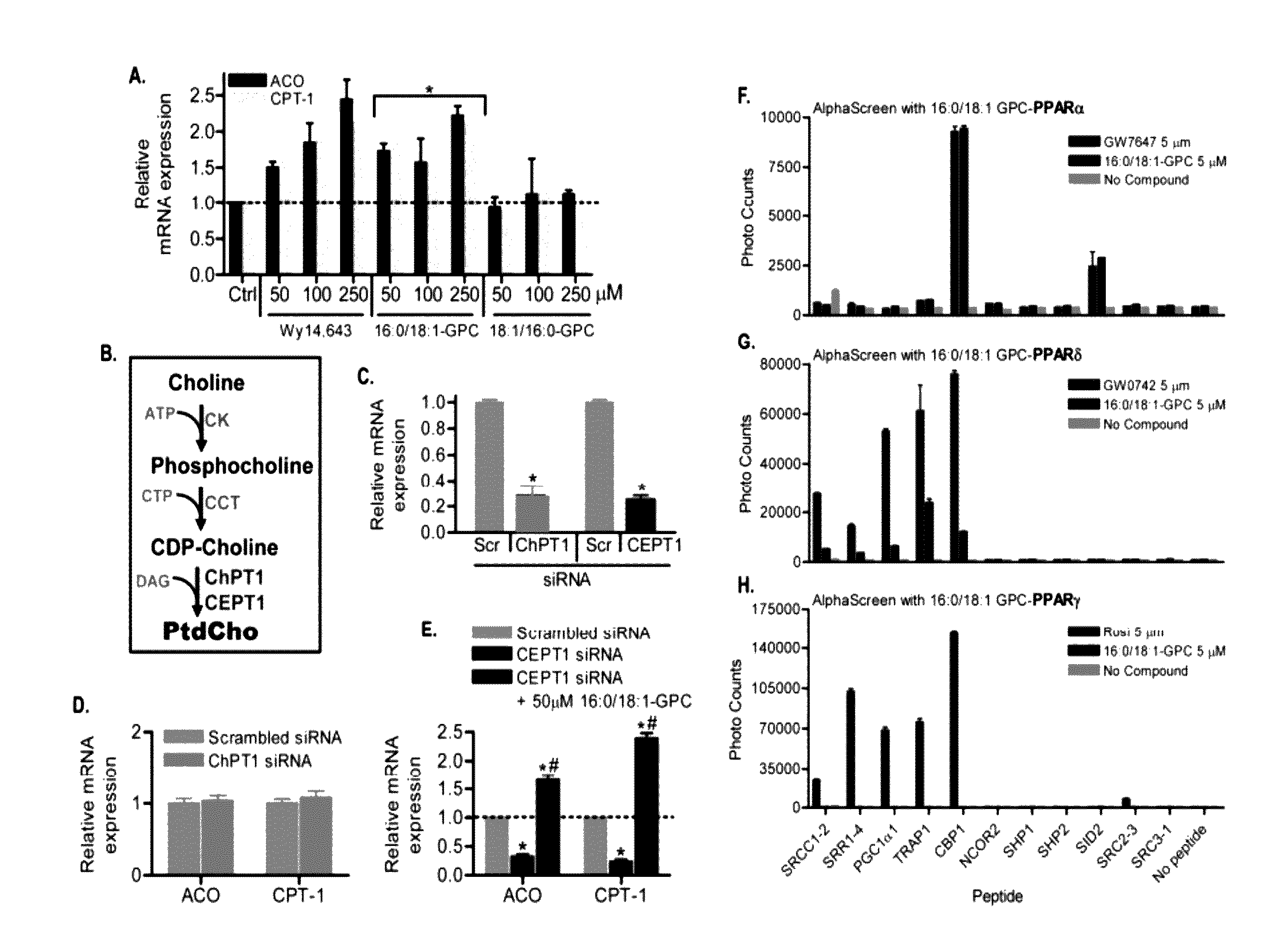Use of an endogenous ligand for peroxisome proliferator activated receptor alpha to treat liver disorders
a technology of activated receptor and proliferator, which is applied in the field of compositions comprising a peroxisome proliferatoractivated receptor alpha (ppar) ligand, can solve the problems of not being authentic endogenous ppar, free fatty acids are not the most physiologically relevant, and the free fatty acids do not bind with sufficient affinity, so as to restore the expression of ppar-dependent genes
- Summary
- Abstract
- Description
- Claims
- Application Information
AI Technical Summary
Benefits of technology
Problems solved by technology
Method used
Image
Examples
example 1
[0100]The primary objective was to identify and characterize an endogenous PPARα ligand and to test the hypothesis that de novo lipid biosynthesis generates the physiologically relevant endogenous ligand 1-palmitoyl-2-oleoyl-sn-glycerol-3-phosphocholine (16:0 / 18:1-GPC) for PPARα. A strategy based on purifying a tagged PPARα molecule from the livers of mice with or without expression of fatty acid synthase (FAS) was developed (see FIG. 1). Fatty acid synthase knockout in liver (FASKOL) mice which manifest impaired PPARα-dependent gene expression that is rescued after pharmacological activation of PPARα (Cell Metab 1, pp. 309-322, 2005) were crossed with PPARα null mice to generate liver-specific FAS knockout mice on a PPARα null background, to reconstitute liver PPARα expression, and to eliminate the possibility of ligand competition between adenovirally transduced PPARα and endogenous PPARα (see FIG. 1).
[0101]Animals and Reagents
[0102]Animal protocols were approved by the Washington...
example 2
[0117]The primary objective was to establish the identity of the phospholipid 1-palmitoyl-2-oleoyl-sn-glycerol-3-phosphocholine (16:0 / 18:1-GPC) as a FAS-dependent physiologically relevant endogenous PPARα ligand. A strategy to employ the use of mass spectrometry analysis of lithiated adducts of glycerophosphocholine lipids from hepatic nuclear extracts was developed to accomplish this objective.
[0118]Electrospray Ionization Mass Spectrometry
[0119]Phosphatidylcholine (GPC), lysophosphatidylcholine (LPC), sphingomyelin (SM), and ceramide (CM) were analyzed as Li+ adducts by positive ion ESI / MS on a Finnigan (San Jose, Calif.) TSQ-7000 triple stage quadrupole mass spectrometer with an ESI source controlled by Finnigan ICIS software. Lipids were dissolved in methanol / chloroform (2 / 1, v / v) containing LiOH (10 pmol / μl), infused with a Harvard syringe pump, and analyzed as described (J Am Soc Mass Spectrom 9, pp. 516-526, 1998; J Am Soc Mass Spectrom 11, pp. 437-449, 2000; J Am Soc Mass Sp...
example 3
[0123]The primary objective was to establish the physiological relevance and binding specificity of 1-palmitoyl-2-oleoyl-sn-glycerol-3-phosphocholine (16:0 / 18:1-GPC) to PPARα. Competitive inhibition and DNA binding activity was employed to address this objective.
[0124]DNA Binding Activity
[0125]Cos-7 cells maintained in DMEM containing 10% fetal bovine serum were transiently transfected with 2 μg of wild type- and DBD-mutant-PPARα plasmids using FuGENE6 (Roche Diagnostics, Indianapolis, Ind.) as described (Cell Metab 5, pp. 59-72, 2007). Nuclear extract DNA binding activity was determined using the PPARα transcription factor assay kit (Cayman Chem, Inc., Ann Arbor, Mich.).
[0126]Binding Assays
[0127]Binding of 16:0 / 18:1-GPC and known agonists to the ligand binding domain (LBD) of PPARα in the presence of various peptide motifs was determined by ALPHASCREEN™ assay (Proc Natl Acad Sci USA 105, pp. 5034-5039, 2008). Experiments used 100 nM receptor LBD, purified as 6× His tag fusion prote...
PUM
| Property | Measurement | Unit |
|---|---|---|
| body weight | aaaaa | aaaaa |
| mass-to-charge ratio | aaaaa | aaaaa |
| weight | aaaaa | aaaaa |
Abstract
Description
Claims
Application Information
 Login to View More
Login to View More - R&D
- Intellectual Property
- Life Sciences
- Materials
- Tech Scout
- Unparalleled Data Quality
- Higher Quality Content
- 60% Fewer Hallucinations
Browse by: Latest US Patents, China's latest patents, Technical Efficacy Thesaurus, Application Domain, Technology Topic, Popular Technical Reports.
© 2025 PatSnap. All rights reserved.Legal|Privacy policy|Modern Slavery Act Transparency Statement|Sitemap|About US| Contact US: help@patsnap.com



